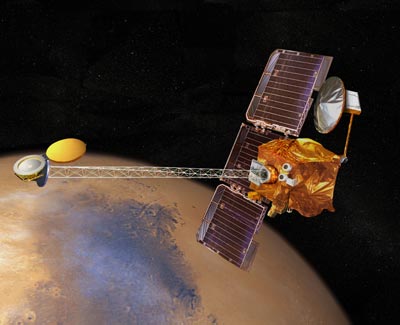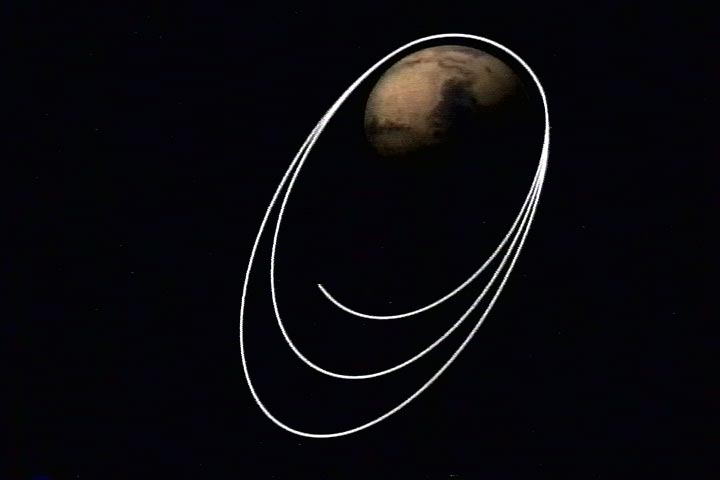






Selected Articles from the
October 2001 Odyssey
Editor: Terry Hancock
- Hollywood Bowl Concert, Diane Rhodes
- Observing the Leonid Meteor Shower, Norm Cook
- A Martian Space Odyssey, NASA/JPL
- Isn't Mars Being Interesting?, NASA/STScI
- The Surf Report, Diane Rhodes
A Martian Space Odyssey
A JPL Press Release
After traveling 200 days and logging more than 460 million kilometers (about 285 million miles), NASA's 2001 Mars Odyssey spacecraft will fire its main engine for the only time Oct. 23 and put itself into orbit around the Red Planet.
 |
| Artists conception of spacecraft 2001 Mars Odyssey around Mars. NASA/JPL/Caltech Click to enlarge. |
Odyssey was launched April 7 from Cape Canaveral Air Force Station, Fla. Other than our Moon, Mars has attracted more spacecraft than any other object in the Solar System, and no other planet has proved as daunting to success. Of the 30 missions sent to Mars by three countries over 40 years, less than one-third have been successful.
``The spacecraft, ground system and flight team are ready for Mars orbit insertion,'' said Matthew Landano, Odyssey project manager at NASA's Jet Propulsion Laboratory, Pasadena, Calif. ``We uplinked the sequence of commands that control the orbit insertion on Oct. 15. Now we will closely monitor the spacecraft's progress as it approaches Mars and executes the orbit insertion burn.''
To enter orbit, Odyssey's propellant tanks, the size of big beach balls, must first be pressurized, plumbing lines heated, and the system primed before 262.8 kilograms (579.4 pounds) of propellant is burned in exactly the right direction for just under 20 minutes.
Flight controllers at JPL will see the main engine burn begin a few seconds after 10:26 p.m. EDT on Oct. 23. The spacecraft will pass behind the planet 10 minutes later and will be out of contact for about 20 minutes. The burn is expected to end at 10:46 p.m. EDT, but controllers will not receive confirmation until the spacecraft comes out from behind Mars and reestablishes contact with Earth at about 11 p.m.
 |
| Simluation of areobraking passes. NASA/JPL/Caltech Click to enlarge. |
The firing of the main engine will brake the spacecraft, slowing and curving its trajectory into an egg-shaped orbit around the planet. In the weeks and months ahead, the spacecraft will repeatedly brush against the top of the atmosphere in a process called aerobraking to reduce the long, 19-hour elliptical orbit into a shorter, 2-hour circular orbit of approximately 400 kilometers (about 250 miles) altitude desired for the mission's science data collection.
NASA's latest explorer carries several scientific instruments to map the chemical and mineralogical makeup of Mars: a gamma ray spectrometer that includes a neutron spectrometer and a high-energy neutron detector; a thermal-emission imaging system; and a Martian radiation environment experiment.
File translated from TEX by TTH, version
2.25.
On 20 Jan 2002, 16:29.
Copyright © 1998-2003 Organization for the Advancement of Space Industrialization and Settlement. All Rights Reserved.